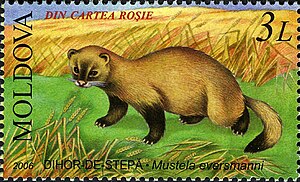Steppe iltis
| Steppe iltis | ||||||||||||
|---|---|---|---|---|---|---|---|---|---|---|---|---|

Steppeniltis ( Mustela eversmanii ) |
||||||||||||
| Systematics | ||||||||||||
|
||||||||||||
| Scientific name | ||||||||||||
| Mustela eversmanii | ||||||||||||
| Lesson , 1827 |
The steppe polecat ( Mustela eversmanii ) is a species of predator from the subgenus polecat within the family of marten (Mustelidae). He lives in Eastern Europe and Asia .
description
The steppe iltis looks very similar to the European or forest iltis , but has a lighter coat and becomes somewhat larger. Like all polecats , it has an elongated, slender body with short limbs. The coat has a low, yellow undercoat and some black guard hairs. The belly and legs are black, it also has a black face mask. In terms of weight and height, it shows a strong sexual dimorphism : while males reach a head trunk length of 37 to 56 centimeters and a weight of up to 2 kilograms, females with 29 to 52 centimeters head trunk length and a maximum weight of 1.3 kilograms are significantly lighter.
distribution and habitat
The steppe iltis occurs in Eastern Europe and parts of Asia . Its western distribution limit runs in the eastern parts of Poland, the Czech Republic and Austria. To the east, its distribution area extends across Central Asia to Manchuria . It inhabits open areas such as steppes and semi-deserts, but also lives in fields and in wasteland. It does not occur at all in forests and towns.
Way of life
Steppe iltiss usually live in the vicinity of Ziesel structures, these animals are its main food. However, it also preyed on hamsters and pipefish . To do this, he digs the animals out of their burrows. He seldom eats insects and completely avoids vegetable foods. When the food supply becomes scarce, the steppe iltis moves to another area. The animals live in burrows of strange animal species, such as hamsters, rabbits or ground squirrels. They relieve themselves at the exit of their den. They can make a number of different sounds, including whining, hissing, and yapping. The steppe iltis has the ability to squirt a liquid out of the anal glands .
Reproduction
The mating season is in February and March, after around 40 days of gestation, the female gives birth to her offspring in April or May. The litter size is significantly larger than that of the European polecat and is four to 18 (average eight to ten). At around a month their eyes open, at a month and a half they are weaned and accompany their mother on hunting trips. At three months they are self-employed and sexually mature at around nine months.
Steppe iltis and people
Because it eats rodents that are considered pests , the steppe iltis is generally met with benevolence. It is not exactly clear whether the domesticated polecat form of the ferret ultimately goes back to the European or the steppe polecat . Sometimes it is hunted for its polecat fur , but not to the same extent as related species.
Hazard and protection
The species is not considered endangered worldwide, but this does not apply to the territory of the European Union: Here ( EU-25 ) the steppe iltis is listed as "critically endangered" ( EN ) in the red list .
The Fauna-Flora-Habitat Directive has included the steppe iltis in Annexes II and IV since 2004. This results in the obligation for the EU states to designate protected areas in the natural range of the species and to introduce a strict protection system for the species inside and outside the protected areas which, among other things, must prohibit hunting and any damage to or destruction of breeding sites or resting places. Bulgaria , Austria , Poland , Romania , Slovakia , the Czech Republic and Hungary have a share in the natural range of the species within the EU.
In the EU countries, the conservation status of the species in the Black Sea region is classified as inadequate and in all other occurrence areas as poor (as of February 2014).
swell
Individual evidence
- ↑ TEMPLE, HJ & TERRY, A. (Comp., 2007): The Status and Distribution of European Mammals, IUCN Red List of Threatened Species - Regional Assessment . 60 pp.
- ↑ European Topic Center on Biological Diversity (2014): Species Assessments at EU Biogeographical Level . Retrieved June 26, 2014.
literature
- Ronald M. Nowak: Walker's Mammals of the World . Johns Hopkins University Press, 1999 ISBN 0-8018-5789-9
Web links
- Mustela eversmanii in the endangered Red List species the IUCN 2008. Posted by: Tikhonov, A. Cavallini, P. Maran, T. Krantz, A., Stubbe, M., Krystufek example, Abramov A. & Wozencraft, C., 2008. Retrieved October 19, 2008.
- Polecat fur
